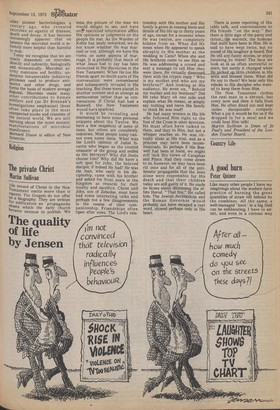Science,.
Mighty microbes
Bernard Dixon
Termites are usually regarded as unmitigated nuisances — as pests to be destroyed whenever and whatever possible. A recent book — called, appropriatelY enough, Termites, A World Problem, by N. E. Hickin (Hutchinson) — estimates the cost of worldwide termite damage and control at 1.2 billion dollars a year There is, it seems, little to be said in favour of the so-called ' white ant,' which has long been categorised as one of the world's most unwanted nuisance species,
Grossly inconvenient for this simplistic view is some research just reported from the bacteriology and entomologY departments at the University of Wisconsin. This suggests that termites may well be of considerable ecological value in maintaining soil fertility in tropical regions
Not only do they play an important role in breaking down dead trees and other forms of cellulose, but worker insects, and to a lesser extent the soldiers, are also involved in 'fixing' nitrogen from the atmosphere and thus replenishing this essential element in the soil.
Investigations into the way in which termites perform both tasks have revealed what could be a previously unknown form of symbiosis between termites and bacteria — one of considerable sophistication whose full implicatons have yet to be determined. The gist of it is that termites plaY host to bacteria capable of digesting cellulose, and also to those which fix atmospheric nitrogen. The microbes concerned live in the termites' gut and their presence may explain the remarkable ability of the insects to survive with only cellulose as a food material. Some termites, for example, can live on a diet consisting of nothing more than filter paper.
The research that has shown the, unexpected and surprising abilitY
of bacteria in termites to fix nitrogen—a skill apparently unique
to termites — was conducted by Dr John Breznak and his colleagues. Describing their work
last week in Nature (vol 244, P
577), they point out that they are not yet certain about the precise relevance of nitrogen fixation to the vitality of the insects. While the soil obviously gains from replenishment by nitrogenous, substances (and from the termites activity in promoting soil aeration and drainage, and in digesting cellulose), the insects' dependence on this source of nutrition is more obscure.
What is clear, however, is the light thrown on yet another aspect
of the reliance of Homo sapiens oe the microbial world. Ever since the work of Louis Pasteur and the
Other pioneer bacteriologists a century ago, who revealed microbes as agents of disease, death and decay, it has become increasingly apparent that on balance the microbial world is infinitely more helpful than harmful to man.
Today we recognise that we are totally dependent on microbes, directly and indirectly, biologically and economically. Microbial activity maintains soil fertility, underpins innumerable industrial Processes used to produce antibiotics and other drugs, and forms the basis of modern sewage disposal. Microbes make many other contributions to human welfare and (as Dr Breznak's investigations emphasise) these often take place in the most unexpected nooks and crannies of the natural world. We are still learning about the more esoteric manifestations of microbial munificence. Bernard Dixon is editor of New Scientist.

































 Previous page
Previous page